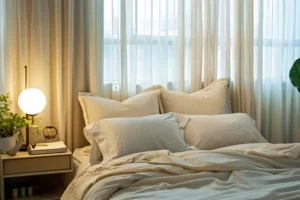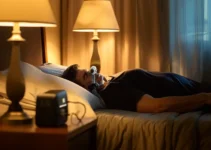The Epworth Sleepiness Scale (ESS) is a simple self-administered questionnaire designed to measure your general level of daytime sleepiness. By rating the likelihood of dozing off in different situations, the scale reveals insights into how sleep affects your daily activities. Recognized globally by sleep experts, the ESS helps identify symptoms of sleep disorders such as narcolepsy and sleep apnea. Understanding your score can be crucial in addressing any sleep-related issues with your healthcare provider and enhancing overall well-being.
Understanding the Epworth Sleepiness Scale
The Epworth Sleepiness Scale (ESS) is a simple, self-administered questionnaire that measures a person’s general level of daytime sleepiness. Developed in 1991 by Dr. Murray Johns at the Epworth Hospital in Melbourne, Australia, the ESS has become an essential tool in the diagnosis of sleep disorders. Understanding this scale can provide valuable insights into your sleep health and guide you towards necessary medical consultations or lifestyle changes.
Given the increasing prevalence of sleep disorders such as sleep apnea and narcolepsy, the significance of tools like the ESS cannot be overstated. With an aging population and the rise in sedentary lifestyles, more individuals are experiencing issues related to sleep deprivation. The ESS provides a quick and efficient way to quantify sleepiness, potentially highlighting underlying health issues that require further investigation.
What is the Epworth Sleepiness Scale?
The Epworth Sleepiness Scale is a widely used method for assessing an individual’s propensity to fall asleep during routine daily activities. The scale consists of eight questions, each asking the respondent to rate their likelihood of dozing off in different situations. These situations range from sitting and reading to sitting in traffic, all of which are common scenarios where drowsiness can manifest. Each question is scored on a scale from 0 to 3:
- 0: Would never doze
- 1: Slight chance of dozing
- 2: Moderate chance of dozing
- 3: High chance of dozing
The higher the total score, the greater the person’s daytime sleepiness, and potentially, the more severe their underlying sleep disorder.
The ESS is not just a diagnostic tool for sleep specialists. General practitioners, psychologists, and other healthcare providers also use it to gauge the impact of sleepiness on a patient’s daily life. The results can then inform decisions about whether to refer the patient for further sleep studies or other forms of medical intervention.
How to Take the Epworth Sleepiness Scale Test
Taking the Epworth Sleepiness Scale test is straightforward and can be completed in just a few minutes. The test requires no special preparation and can be done at home or in a clinical setting. The respondent simply answers the eight questions based on their recent experiences.
To take the test, follow these steps:
- Find a quiet place where you can focus without distractions.
- Carefully read each question and think about your likelihood of dozing off in each situation over the past few weeks.
- Assign a score from 0 to 3 for each question, reflecting your chance of dozing off.
- Add up your scores to get a total score.
It’s important to answer honestly, as the accuracy of the test depends on truthful responses.
The ESS is often included as part of a comprehensive sleep assessment. Your healthcare provider may also ask you to maintain a sleep diary or undergo overnight sleep studies to get a fuller picture of your sleep patterns and issues.
Interpreting Your Results
Once you’ve completed the Epworth Sleepiness Scale, interpreting your results is the next crucial step. The total score can range from 0 to 24. Here’s a general guideline for understanding what your score may indicate:
- 0-7: It is unlikely that you are abnormally sleepy.
- 8-9: You have an average amount of daytime sleepiness.
- 10-15: You may be excessively sleepy and might benefit from a medical consultation.
- 16-24: You are likely to be excessively sleepy and should seek medical attention as soon as possible.
These thresholds provide a baseline, but they are not definitive diagnoses. A high score suggests the need for further evaluation by a healthcare provider, possibly leading to additional testing such as polysomnography or multiple sleep latency tests.
It’s essential to discuss your results with a healthcare professional who can take into account your overall health, lifestyle, and other factors. Daytime sleepiness can be a symptom of various conditions, including sleep apnea, narcolepsy, and even depression, so a comprehensive approach to diagnosis and treatment is recommended.
Understanding your level of daytime sleepiness is a vital step toward improving your overall health and well-being. For more insights into sleep health, be sure to explore our other articles on sleep hygiene, disorders, and treatments.
The Importance of Recognizing Sleep Disorders
Sleep is a fundamental component of human health, influencing everything from cognitive function to emotional stability. Recognizing sleep disorders is crucial because these conditions can severely impact overall well-being. Recent studies have shown that untreated sleep disorders can lead to various health issues, including cardiovascular diseases, depression, and weakened immune function.
Moreover, sleep disorders often exacerbate other medical conditions, creating a vicious cycle that can be hard to break. For instance, individuals with sleep apnea are more likely to suffer from hypertension and diabetes. Recognizing and treating sleep disorders can thus act as a preventive measure against more severe health problems.
Understanding the importance of diagnosing sleep disorders is the first step toward a healthier lifestyle. With proper treatment, many people experience dramatic improvements in their quality of life, including increased energy levels, better mood, and enhanced cognitive abilities. Therefore, it’s essential to be aware of the signs and symptoms that may indicate a sleep problem.
Common Sleep Disorders Linked with Excessive Daytime Sleepiness
Excessive daytime sleepiness is a common symptom that can indicate several underlying sleep disorders. Obstructive sleep apnea (OSA) is one of the most prevalent conditions associated with this symptom. OSA occurs when the airway becomes blocked during sleep, leading to repeated interruptions in breathing. This not only disrupts sleep but also results in a lack of oxygen reaching vital organs.
Narcolepsy is another condition often linked to excessive daytime sleepiness. Unlike OSA, narcolepsy is a neurological disorder that affects the brain’s ability to regulate sleep and wake cycles. People with narcolepsy may suddenly fall asleep at inappropriate times, making everyday functioning challenging.
Other common sleep disorders include insomnia, which can lead to chronic sleep deprivation, and restless legs syndrome (RLS), a condition causing uncomfortable sensations in the legs that disrupt sleep. Each of these conditions requires different diagnostic and treatment approaches, but all share the common symptom of excessive daytime sleepiness.
When to Seek Professional Help
Knowing when to seek professional help for sleep disorders is crucial for effective management. Persistent symptoms like snoring, gasping for air during sleep, or feeling overwhelmingly tired during the day should not be ignored. These could be signs of sleep apnea, which needs medical intervention.
If you find yourself experiencing chronic insomnia—difficulty falling or staying asleep for months—or symptoms of narcolepsy such as sudden muscle weakness or uncontrollable sleep attacks, it’s time to consult a healthcare provider. Early intervention can help diagnose the condition accurately and commence appropriate treatment.
It’s also advisable to seek help if sleep disorders start affecting your daily performance, relationships, or overall quality of life. A sleep specialist can conduct various tests, including polysomnography, to get to the root of the issue and recommend suitable treatment options.
Treatment Options for Sleep Disorders
Treatment for sleep disorders varies depending on the specific condition and its severity. Continuous Positive Airway Pressure (CPAP) therapy is the gold standard treatment for obstructive sleep apnea. It involves wearing a mask that provides a continuous stream of air to keep the airways open during sleep. Other options for OSA include oral appliances and in some severe cases, surgery.
For narcolepsy, a combination of medications and lifestyle changes is usually recommended. Stimulants can help manage excessive daytime sleepiness, while antidepressants may be prescribed to control cataplexy and other symptoms. Scheduling regular naps and maintaining a consistent sleep routine can also be beneficial.
Insomnia often requires a multi-faceted approach, including cognitive-behavioral therapy for insomnia (CBT-I), medication, and lifestyle changes. CBT-I has been found to be highly effective in treating chronic insomnia by helping individuals change thoughts and behaviors that negatively impact sleep.
Other sleep disorders like restless legs syndrome may be managed with medications that reduce symptoms or lifestyle changes such as regular exercise and avoiding caffeine or alcohol before bed. Each treatment plan is typically tailored to the individual’s specific needs.
By recognizing the importance of identifying sleep disorders and understanding the diverse treatment options available, you can take the necessary steps to improve your sleep quality and overall health. For more insights and tips on managing sleep issues, check out our other articles that delve deeper into each condition and its treatments.
Improving Your Sleep Hygiene
Good sleep hygiene encompasses a set of routines and practices that are necessary to have good nighttime sleep quality and full daytime alertness. Proper sleep hygiene can help manage a multitude of health issues, promote longevity, and improve quality of life. Investing time and effort into improving your sleep hygiene can lead to significant improvements in overall well-being.
Sleep hygiene plays a crucial role in maintaining both mental and physical health. Poor sleep can lead to various health issues such as cardiovascular diseases, obesity, and even mental health disorders. Developing and adhering to consistent sleep hygiene practices can mitigate these risks and lead to a more productive and satisfying life.
Understanding the various aspects of sleep hygiene and implementing the necessary changes can be a transformative journey. From adjusting your daily habits to making changes in your sleep environment, there are numerous ways to enhance the quality of your sleep.
Tips for Better Sleep
Establishing a regular sleep schedule is one of the fundamental principles of good sleep hygiene. Going to bed and waking up at the same time every day helps regulate your body’s internal clock. This consistency can greatly improve the ease with which you fall asleep and wake up.
Creating a relaxing bedtime routine can signal to your body that it’s time to wind down. Activities such as reading a book, practicing mindfulness, or taking a warm bath can help transition your mind and body into a more relaxed state, making it easier to fall asleep.
It’s important to make your sleep environment comfortable and conducive to rest. This includes using comfortable bedding, keeping the room cool, and minimizing noise and light. Investing in blackout curtains, earplugs, or white noise machines can make a significant difference in the quality of your sleep.
The Role of Diet and Exercise in Sleep Quality
A balanced diet and regular exercise are key components of overall health and play a significant role in sleep quality. Consuming a diet rich in fruits, vegetables, lean proteins, and whole grains can help promote better sleep. On the other hand, consuming heavy meals, caffeine, and alcohol close to bedtime can disrupt your sleep. Regular physical activity can help you fall asleep faster and enjoy deeper sleep. However, it’s important to time your exercise appropriately. Engaging in vigorous exercise too close to bedtime can have the opposite effect. Aim to complete your workout at least a few hours before you plan to go to bed.
Hydration also plays a role in sleep quality. While staying hydrated throughout the day is important, try to limit the intake of fluids close to bedtime to avoid waking up frequently during the night to use the bathroom.
Using Technology to Monitor and Improve Sleep
In today’s digital age, various technologies can help monitor and improve sleep. Sleep-tracking devices and apps can provide insights into your sleep patterns, helping you identify areas for improvement. These tools often measure various metrics such as sleep duration, sleep stages, and disturbances.
White noise machines and apps can be used to create a soothing sleep environment by masking background noise. This can be particularly beneficial if you live in a noisy area or have trouble falling asleep due to ambient sounds.
Smart lighting systems can help regulate your sleep-wake cycle by simulating natural light patterns. These systems can gradually dim the lights in the evening to signal that it’s time to wind down and gradually brighten in the morning to help you wake up naturally.
While technology can be a helpful tool in improving sleep quality, it’s important to use it mindfully. Excessive use of electronic devices before bed can have the opposite effect, as the blue light emitted by screens can interfere with your body’s production of melatonin, a hormone that regulates sleep.
Improving your sleep hygiene is a journey that involves making conscious changes to your daily habits and sleep environment. By exploring this topic further and implementing the tips provided, you can experience better sleep quality and overall improved well-being. Don’t stop here; continue to learn and read about related topics to enhance your understanding and keep improving your lifestyle.
Common Questions About the Epworth Sleepiness Scale
Understanding how to evaluate sleep patterns can be crucial for identifying sleep disorders. The Epworth Sleepiness Scale (ESS) is a simple and widely used tool for this purpose. Here are a few common questions related to the ESS.
What is the Epworth Sleepiness Scale used for?
The Epworth Sleepiness Scale is primarily used to measure daytime sleepiness, which helps assess the severity of sleep disorders like sleep apnea and narcolepsy. It consists of a short questionnaire that asks individuals to rate their likelihood of falling asleep in various everyday situations.
How do I interpret my Epworth Sleepiness Scale score?
Scores on the ESS range from 0 to 24. A score of 10 or more indicates that you may be experiencing excessive daytime sleepiness, and it is advisable to consult a healthcare provider for a deeper assessment. Lower scores typically suggest a normal level of daytime sleepiness.

My name is Salman Kapa, a 73-year-old expert in bone regeneration and dental implantology. With decades of experience in the field, I am dedicated to advancing our understanding of oral health and hygiene. Through my research and writing, I aim to contribute to the development of innovative solutions in dental care.




